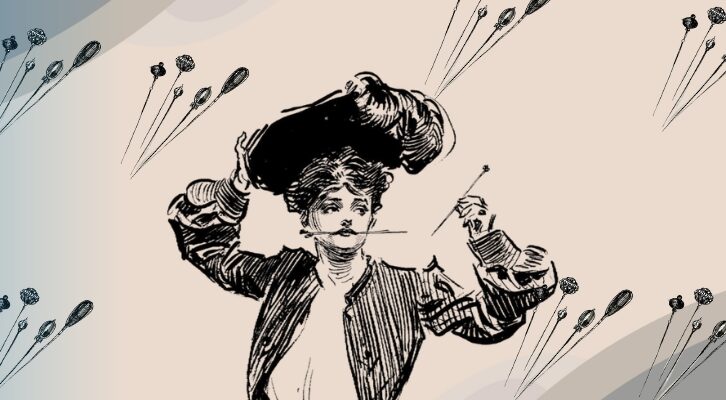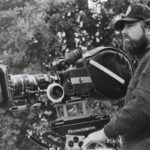
100 Books Across America: Fiction and Nonfiction for Every State in the Union
A Reading List for Your Last-Second Literary Road Trip
It seems as though everyone is traveling right now—students and teachers are heading off to new cities or returning to old ones for the fall semester, friends are kicking off last-ditch road trips, and 1 in 3 New Yorkers are using their vacation days to sweat out the last of August in literally any other place they can get to.
I don’t know about you, but whenever I’m visiting a new place, and particularly if I’m going to spend a good deal of time there, I like to find my way in with a book—either a book about the history of the area or one that’s simply set there, so that I can get a feel for its rhythms, the cadences and locations that will soon become familiar to me. That is, I’m looking for a kind of recognition. A reference point, if you will.
In case you feel the same, and in case you’re going somewhere new this season (or any time in the future, really), I’m recommending two books—one fiction and one non-fiction—set in (or at least concerning) every state in America for your exploratory reading pleasure. I’ll also be noting the most famous book set in each state, just so you don’t miss out on the classics. (The “most famous book,” by the way, is a designation reached in part by consulting this list, but also by deviating from it whenever the general opinion of the Lit Hub office differed—so, admittedly these have been chosen by consensus and not by science, but then again, if there’s a truly scientific approach to which books are more famous than which other books, I’d like to hear it.) I’ve tried to avoid repetition as much as possible, opted for books that do a good job of evoking place where possible, and aimed for a mix of old and new, well-known and obscure.
Now, to be fair: this is an impossible task. There’s no way to actually sum up a whole state in a single text, or in three (or even stretching the rules with California and New York, to which I’ve assigned six), nor am I an expert in the local literary heroes of every state (though I hope I’ve done my research as well as I can) and so consider all these recommendations simply starting places—and please add further suggestions at will.
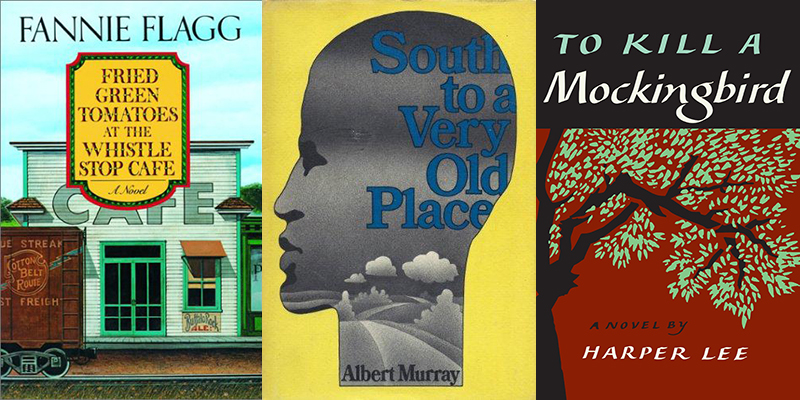
Alabama
Fiction: Fried Green Tomatoes at the Whistle Stop Café, Fannie Flagg
Female friendships aren’t a new thing in literature, despite recent high temperatures induced by Ferrante-fever. This classic of Alabama fiction centers on the unlikely relationship—a friendship built, more than anything, on storytelling—between an 86-year-old woman in a nursing home and an unhappy middle-aged housewife. But it’s also a portrait of a community, and addresses issues of violence, race, homosexuality and aging over more than half a century. Fun fact: when the book was adapted into a film in 1991, Flagg wrote the screenplay, and was nominated for an Academy Award for her work.
Nonfiction: South to a Very Old Place, Albert Murray
Jazz critic, novelist and essayist Albert Murray’s lyrical memoir about growing up in Alabama in the 1920s and 30s is steeped in music and reflection—on race, on youth, on the nature of home. Toni Morrison put it this way in The New York Times: “[Murray’s] perceptions are firmly based in the blues idiom, and it is black music no less than literary criticism and historical analysis that gives his work its authenticity, its emotional vigor and its tenacious hold on the intellect. His special gift is in the manipulation of politics and poetry, of art and history, of folklore and statistics—a manipulation so deft it is impossible, unnecessary and certainly undesirable to separate them.”
A few other Alabama-based works of non-fiction deserve mention here: All Over But the Shoutin’, Rick Bragg’s memoir about growing up “poor white trash,” as he put it, and becoming a Pulitzer Prize-winning journalist; Just Mercy, a memoir by Bryan Stevenson, a tireless attorney (John Grisham compared him favorably to Atticus Finch) who runs the Equal Justice Initiative in Montgomery, which has been frequently assigned to incoming college freshmen in recent years—for good reason; and Let Us Now Praise Famous Men, James Agee and Walker Evans’s affecting postmodern investigation into the lives of Depression-era sharecroppers.
The Famous Option: To Kill a Mockingbird, Harper Lee

Alaska
Fiction: The Snow Child, Eowyn Ivey
In this adaptation of a Russian fairy tale, set in Alaska in 1920 (which is probably as much like Russia as America has ever gotten), a pioneer couple desperate for a child builds one out of snow—and in the morning, they find that she has come alive. Ivey is a native Alaskan, and she manages to evoke the magic and violence of the place in equal measure.
For an opposite experience—that is, a novel that has no magic whatsoever, but rather is a bone-chillingly accurate account of life in Alaska—you may want to go for Ordinary Wolves, by Seth Kantner, about a young man who loves the bush but (like so many) feels the lure of the city.
Nonfiction: The Last Light Breaking, Nick Jans
Nick Jans is a celebrated chronicler of Alaska, both as a writer and as a photographer; his first book is a collection of essays about the time he spent living among the Inupiat Natives in the small village of Ambler, Alaska, a culture of the past being confronted with the future.
The Famous Option: The Call of the Wild, Jack London
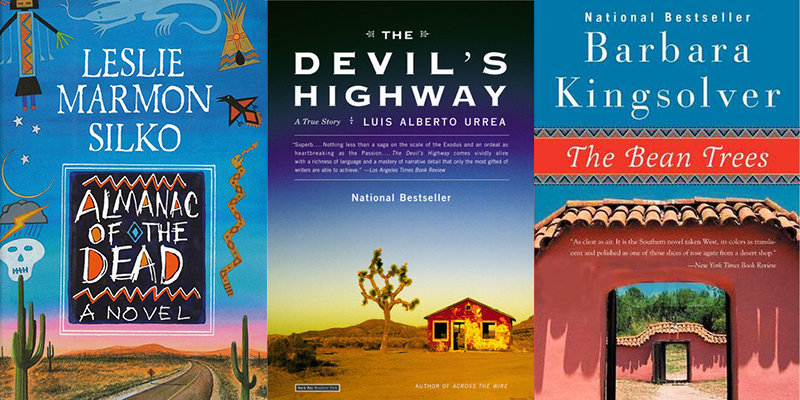
Arizona
Fiction: Almanac of the Dead, Leslie Marmon Silko
A marvelous tapestry of narrative and voice that tells multiple stories from multiple times but more or less centers on contemporary Tucson, and the woman who is translating what may be an apocalyptic Aztec prophecy. Drug-dealers, shamans, revolutionaries, deviants, psychics and crime-lords cross and recross one another to create a grim cacophony of Native American history, experience and anger.
Nonfiction: The Devil’s Highway: A True Story, Luis Alberto Urrea
A finalist for the Pulitzer Prize and essential reading for anyone with any kind of a opinion about any kind of wall, this book follows the fates of 26 Mexican men who crossed into Arizona via “the Devil’s Highway”—which is called that for all of the reasons you think—and unpacks “the politics of stupidity that rules both sides of the border.” On his website, Urrea writes of the book: “It weighs heavy on my heart. Almost impossible to discuss it anymore. The ghosts of the forgotten enter the room sometimes. The book has made me many friends—some enemies. Border Patrol agents sometimes give me gifts. We all want a fair shake. We all need a witness. WWJD: Who Would Jesus Deport?”
The Famous Option: The Bean Trees, Barbara Kingsolver
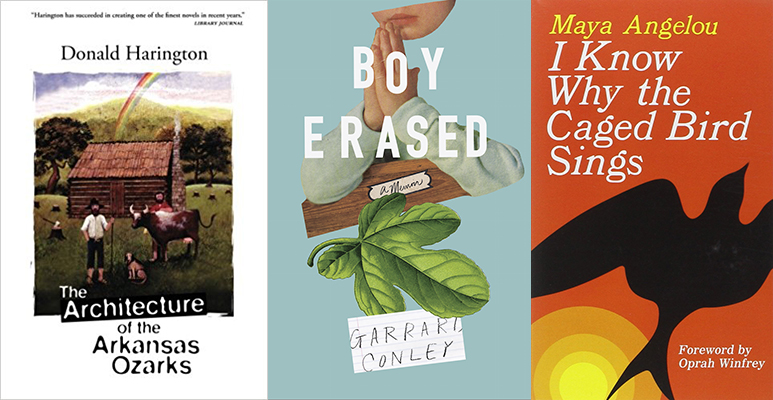
Arkansas
Fiction: The Architecture of the Arkansas Ozarks, Donald Harington
Donald Harington is a perfect cult author—not very widely read, but when read, obsessed over, not to mention compared to Nabokov, Faulkner, and García Márquez. Most of his many novels are set in the fictional Arkansas town of Stay More, and The Architecture of the Arkansas Ozarks (TAO TAO) is a thesis statement of sorts on his entire oeuvre, a self-referential, wordplay-heavy, bawdy, post-modern portrait of Harington’s personal Arkansas and six generations of its settlers, told as an architectural investigation complete with hand-drawn illustrations of the town’s buildings. As Izzy Grinspan put it in The Believer, “There’s a lot of sex in TAO TAO—the Ingledew men are always worrying about their “tallywhackers”—but there’s also a lot of etymology. Harington uses both to answer the central question of TAO TAO, which is the central question of all backward-looking epics: how did things get to be the way they are?”
Nonfiction: Boy Erased, Garrard Conley
In Conley’s 2016 memoir, he recounts his childhood as the son of a Baptist minister in a small Arkansas town—and what happened when he, at nineteen, was forced to undergo gay conversion therapy or risk losing his family.
The Famous Option: I Know Why the Caged Bird Sings, Maya Angelou
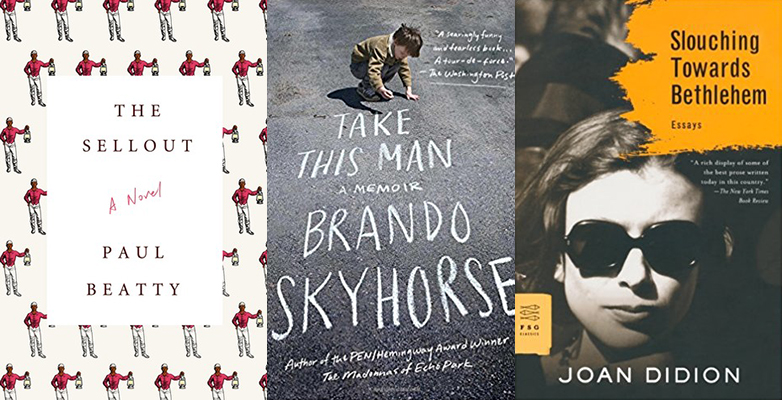
California
Fiction: The Sellout, Paul Beatty · Pocho, José Antonio Villarreal
California, I’m (not that) sorry to say, is just too big—both spatially and in the American consciousness—to cover with a single book. It’s also too big to cover with a hundred books, but we all do what we can. Here, I’ll recommend two, beginning with Paul Beatty’s difficult and hilarious The Sellout, which took home a slew of awards last year, and for good reason—it’s the most effective satire in recent memory, a provocative explosion of prose and police and politics, and is likely to become a milestone novel of the decade. For an older classic, try Pocho, a landmark work of Chicano literature that tells the story of a young Mexican-American boy, the child of immigrants, coming into his own—with some difficulty—in Depression-era California.
Nonfiction: Take This Man, Brando Skyhorse · The History of Forgetting: Los Angeles and the Erasure of Memory, Norman M. Klein
When Brando Skyhorse was three years old, his parents—both Mexican—split, his father fleeing from his dysfunctional mother. His mother took on a Native American identity, changing her name and raising Brando to believe that he was the son of an imprisoned Native American political activist, while presenting him with stepfather after errant stepfather. Only at 30 does he discover his actual origins, and begin to edge closer to his real father and true identity. If you’re not in the mood for memoir, you might try The History of Forgetting, a multi-generic “anti-tour” of Los Angeles that looks specifically at erasure—of neighborhoods, of cultures, of history—and investigates the way noir fiction and Hollywood films have represented the architecture, both internal and external, of the city.
The Famous Option: The Grapes of Wrath, John Steinbeck · Slouching Towards Bethlehem, Joan Didion

Colorado
Fiction: Plainsong, Kent Haruf
A stark novel about the citizens of a tiny town tucked far away on the Colorado plains, and the way their lives unfold over the course of a year. But the sensations of place are as much the thrust of this novel as the characters in question—or perhaps it’s better to say that the prairie itself is a character, and one that binds all the others together.
Nonfiction: Where the Water Goes, David Owen
Water is our most important life-sustaining resource—and it’s going away. The Colorado River has shaped the American West for decades, geographically and politically, and the situation is deeply complicated. Owen’s exploration of the river, which takes him from Colorado to Mexico, examines the complex infrastructure, the water wars, the dangers, and the countless unanswerable questions about the future.
The Famous Option: The Shining, Stephen King
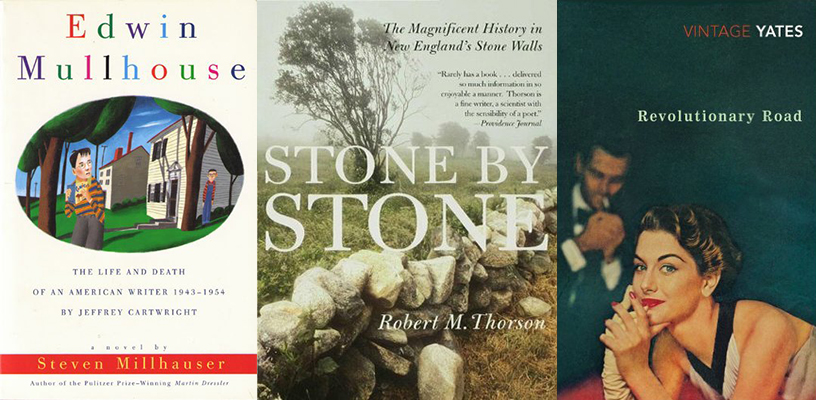
Connecticut
Fiction: Edwin Mullhouse: The Life and Death of an American Writer 1943-1954, by Jeffrey Cartwright, Steven Millhauser
When I think of Connecticut, I think of Edwin Mullhouse—or rather, I think of a certain kind of semi-repressed, wholly-bored suburban childhood that could give rise to Jeffrey Cartwright, the kind of kid who would obsess over his supposedly-brilliant next door neighbor enough to write his biography after his untimely death, age eleven. Like much of Millhauser’s work, it’s both savage satire and nostalgic portraiture, and like all of Millhauser’s work, it’s completely brilliant.
Nonfiction: Stone by Stone, Robert Thorson
If you’ve spent any time in New England, you’ve seen them: old stone walls patterning the fields, sometimes in obvious places, between farms, and sometimes in stranger locales. This book, written by a professor of geology and geophysics at the University of Connecticut, tells the story of the stones, their effect on the landscape, and their relationship to the history of the region.
The Famous Option: Revolutionary Road, Richard Yates
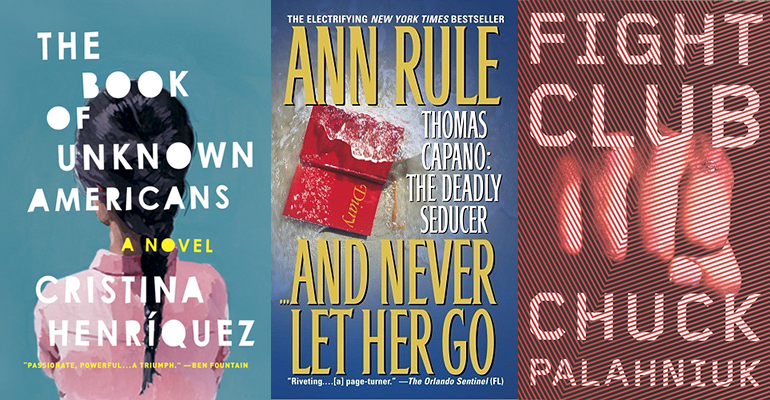
Delaware
Fiction: The Book of Unknown Americans, Cristina Henríquez
A rickety apartment building in Western Delaware. Nine families of new Americans. Teenagers in love. Or, as one character puts it, “the unknown Americans, the ones no one even wants to know, because they’ve been told they’re supposed to be scared of us and because maybe if they did take the time to get to know us, they might realize that we’re not that bad, maybe even that we’re a lot like them. And who would they hate then?”
Nonfiction: Never Let Her Go, Ann Rule
Former Seattle policewoman Anne Rule’s true crime book—her best, as some would have it—tells the story of Thomas Capano, who was one of the most powerful men in Delaware in 1996, when Anne Marie Fahey, his mistress (as it turns out, one of many) disappeared. Or, put in headline terms: Charming Sociopath Destroys the Lives of Many.
The Famous Option: Fight Club, Chuck Palahniuk

Florida
Fiction: Ninety-Two in the Shade, Thomas McGuane
No place in America is weirder than Florida, and, despite his Montana roots, McGuane can weird it up with the best of them—particularly in this crazed, excess-soaked Key Westian narrative of family and fishing and feuding.
Nonfiction: The Orchid Thief, Susan Orlean
In this modern classic Orlean, takes the reader into the Florida swamps and the strange world of orchid enthusiasts. On this quest, we meet John Laroche, who is so fixated on the idea of finding and cloning the elusive ghost orchid that he sets off to steal samples from Fakahatchee Strand State Preserve and lands himself in jail. A compelling study of place and obsession that makes it clear: flowers can be just as crazy-making as gold.
The Famous Option: Their Eyes Were Watching God, Zora Neale Hurston
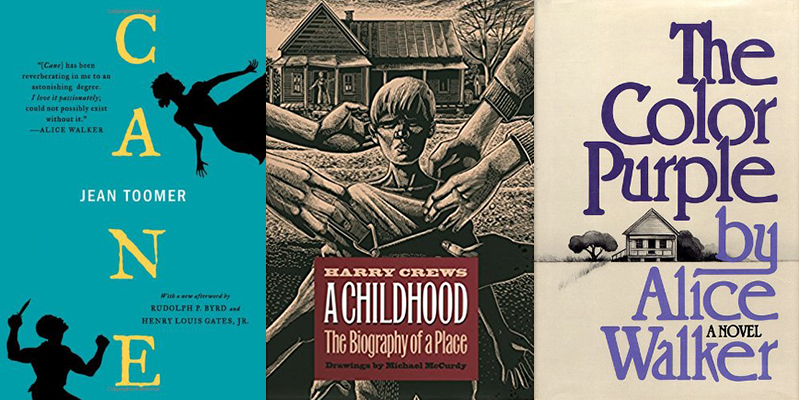
Georgia
Fiction: Cane, Jean Toomer
A touchstone of the Harlem Renaissance, this novel uses poems, drama and fictional vignettes to paint a portrait of life for African-Americans in the 1920s south. It’s a striking book, both formally and lyrically. Plus, the descriptions of the state are pretty phenomenal:
Through a canebrake that was ripe for cutting, the branch was reached. Under a sweet-gum tree, and where reddish leaves had dammed the creek a little, we sat down. Dusk, suggesting the almost imperceptible procession of giant trees, settled with a purple haze about the cane. I felt strange, as I always do in Georgia, particularly at dusk. I felt that things unseen to men were tangibly immediate. It would not have surprised me had I had vision. People have them in Georgia more often that you would suppose.
I should mention the excellent The Heart is a Lonely Hunter, by Carson McCullers, which gives a fairly bleak view of the inhabitants of a small town in 1930s Georgia, and, for all you romantics out there, Gone With the Wind, by Margaret Mitchell.
Nonfiction: A Childhood: The Biography of a Place, Harry Crews
You’ve probably already read Midnight in the Garden of Good and Evil, so how about something a little more terrifying: Harry Crews’s memoir of his young childhood in rural South Georgia, which packs more incident and grotesquerie into the first six years than other memoirists do in a lifetime—not to mention what Dwight Garner called “the most indelible scene in American literary memoir,” the moment when Crews is burned neck to toes in a vat of boiling water. Crews is a wondrous literary madman, and this is the story of the people and places that shaped him.
The Famous Option: The Color Purple, Alice Walker
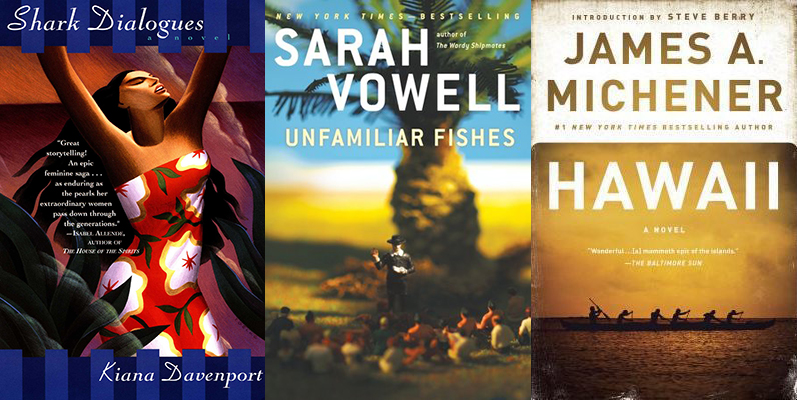
Hawaii
Fiction: Shark Dialogues, Kiana Davenport
A semi-fantastical seven-generation family saga that doubles as the history of Hawaii, Davenport’s first novel centers on Pono, a woman with supernatural gifts, and her four granddaughters, who return home every year from where they have been far-flung, “as if some swerving structure in their cells warped them forever backward to this lush, forbidding matriarch,” to come to terms with their family story.
Nonfiction: Unfamiliar Fishes, Sarah Vowell
A history of the Americanization of Hawaii told in Vowell’s smart-ass, ironic, whirlwind style. “Why is there a glop of macaroni salad next to the Japanese chicken in my plate lunch?” the book begins. “Because the ship Thaddeus left Boston Harbor with the first boatload of New England missionaries bound for Hawaii in 1819. That and it’s Saturday.” This makes for a vivid and amusing—if not exhaustive—exploration of our country’s furthest reaches.
The Famous Option: Hawaii, James A. Michener
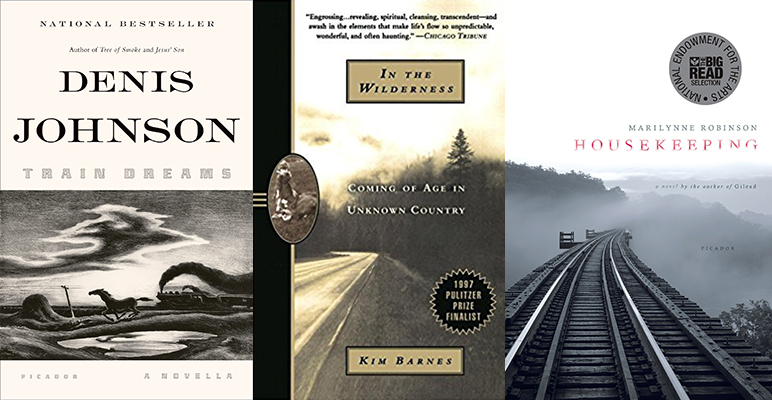
Idaho
Fiction: Train Dreams, Denis Johnson
If you ask me, Train Dreams is the best thing Denis Johnson ever wrote. It is more arresting than Jesus’ Son by miles. The story—all 116 pages of it—begins in familiar territory, with a laborer on the American frontier, and spirals into a devastating surreality that more or less sums up the American experience—at least for some. Throughout is Johnson’s well-crafted, existentialist descriptions of the land in question, like this one:
The wolves and coyotes howled without letup all night, sounding in the hundreds, more than Grainier had ever heard, and maybe other creatures too, owls, eagles—what, exactly, he couldn’t guess—surely every single animal with a voice along the peaks and ridges looking down on the Moyea River, as if nothing could ease any of God’s beasts. Grainier didn’t dare to sleep, feeling it all to be some sort of vast pronouncement, maybe the alarms of the end of the world.
Nonfiction: In the Wilderness: Coming of Age in Unknown Country, Kim Barnes
Poet Kim Barnes’s memoir describes her childhood in the isolation of an Idaho logger camp, and what happened when her father lost his job and turned the family towards fundamentalism. “Perhaps because I was so young,” she writes early on, “what remains with me about those camps is not the trees and mountains, not the streams pulsing with red as the days shortened; what remains is a sense rather than a memory of place, a composite of smells, sounds, and images: the closeness of my parents as they slept beside me when the temperature dropped below zero; my mother’s hair tightly curling around my fingers; cigarettes, coffee, sweat, diesel, the turpentine scent of pine.”
The Famous Option: Housekeeping, Marilynne Robinson
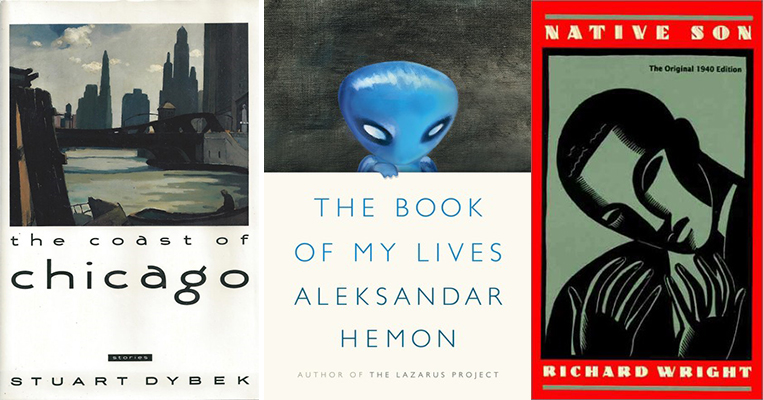
Illinois
Fiction: The Coast of Chicago, Stuart Dybek
Fourteen subtle stories about loners and strangers making their way through the Chicago streets; the second collection from Dybek, who grew up on the South side. These stories take moments of everyday life and elevate them into myth, and sometimes into magic, drawing out the dreamlike seams of experience. As a bonus, it includes the story “Pet Milk,” which is one of my all-time favorites.
See also: The House on Mango Street, by Sandra Cisneros (ousted here in favor of a place in Texas), Knock on Any Door, by Willard Motley, So Big, by Edna Feber, and the Saul Bellow oeuvre.
Nonfiction: The Book of My Lives, Aleksandar Hemon
To be fair, this book is split between the two cities of Hemon’s heart: Chicago and Sarajevo, where he was born. But the Chicago essays in this collection are so luminous that I simply couldn’t put another book in its place. “Reasons Why I Do Not Wish to Leave Chicago: An Incomplete, Random List” alone would be enough to keep it here.
See also, please, Margo Jefferson’s excellent memoir Negroland.
The Famous Option: Native Son, Richard Wright
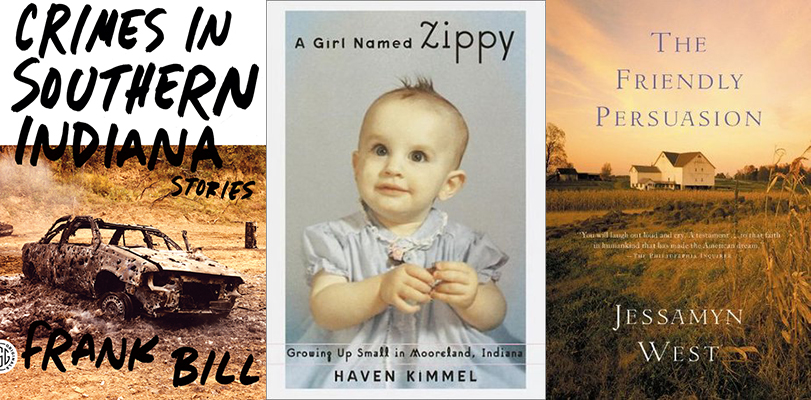
Indiana
Fiction: Crimes in Southern Indiana, Frank Bill
A brutal and bloody debut, interconnected stories that confirm and expand all your worst thoughts about what humans can do to one another—not to mention what Southern Indiana is like. Not for the faint of heart—but certainly possessed of its own kind of elegance and intelligence, and clearly the work of a great writer.
See also: God Bless You, Mr. Rosewater, by Kurt Vonnegut and Underground Airlines, by Ben H. Winters
Nonfiction: A Girl Named Zippy: Growing up Small in Mooreland, Indiana, Haven Kimmel
A witty ode to a youth spent in a town with a population of only 300—a town that by some “mysterious and powerful mathematical principle,” had had a population of only 300 for decades. “Sociologists and students of history imagine they know something of the United States in the sixties and seventies because they are familiar with the prevailing trends,” Kimmel writes in the prologue, “if they drew assumptions about Mooreland based on that knowledge, they would get everything wrong.” Well, now they won’t have to.
The Famous Option: The Friendly Persuasion, Jessamyn West
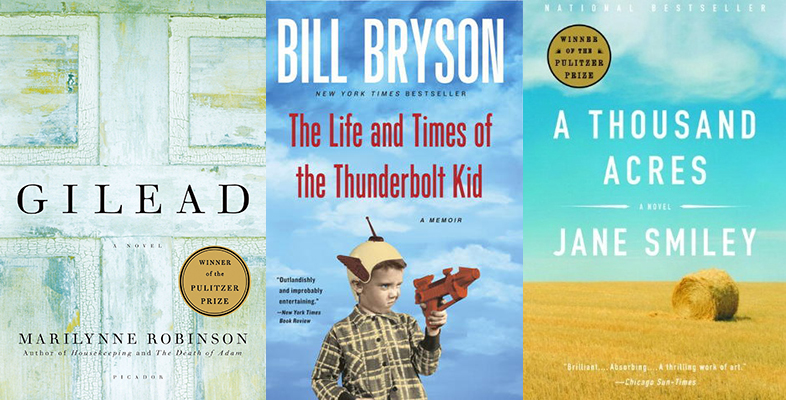
Iowa
Fiction: Gilead, Marilynne Robinson
Marilynne Robinson is a national treasure, and Gilead is the first in her trilogy about the eponymous town of Gilead. The novel centers on Reverend John Ames, who is one of President Obama’s favorite literary characters, by the by—in a conversation the two had in Des Moines, the President called him “gracious and courtly and a little bit confused about how to reconcile his faith with all the various travails that his family goes through. And I was just—I just fell in love with the character, fell in love with the book, and then you and I had a chance to meet when you got a fancy award at the White House.” Gilead won both the Pulitzer prize and the National Book Critics Circle Award for fiction in 2005.
For another direction entirely, you may want to try Universal Harvester, by John Darnielle, a modern work of techno-horror, also quite good.
Nonfiction: The Life and Times of the Thunderbolt Kid, Bill Bryson
From one of the most affable writers around, a memoir of growing up in Des Moines in the 1950s, aided by one very specific persona (I bet you can guess).
The Famous Option: A Thousand Acres, Jane Smiley
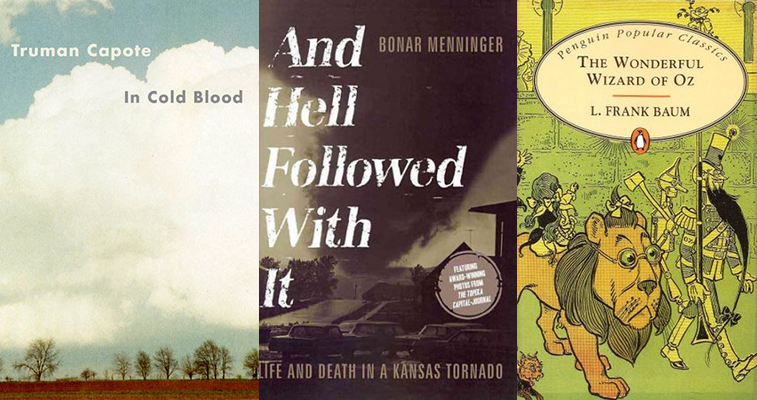
Kansas
Fiction: In Cold Blood, Truman Capote
At this point, Capote’s “nonfiction novel” is about as famous as The Wizard of Oz, but I’ve made an executive decision here and counted the latter below. The book tells the story of the brutal 1959 murders of the Clutter family in Holcomb, Kansas, and is based on Capote’s investigative work (Harper Lee came along), but also contains quite a number of changed facts, invented scenes, and literary liberties—hence its location in the fiction section.
Nonfiction: And Hell Followed With it: Life and Death in a Kansas Tornado, Bonar Menninger
In case you’d like to know what happens to those who don’t get magically transported to Oz when the tornado hits.
The Famous Option: The Wonderful Wizard of Oz, L. Frank Baum
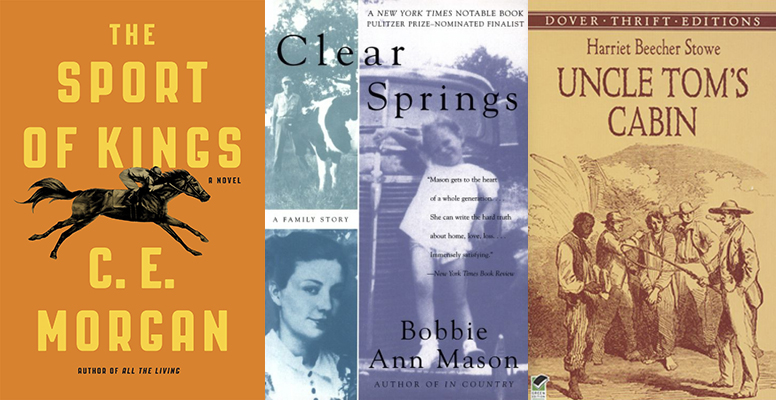
Kentucky
Fiction: The Sport of Kings, C. E. Morgan
“This is what happens when you get complacent,” one character tells another in Morgan’s phenomenal, Pulitzer-finalist novel, “when you don’t have the courage to dream big or grab the opportunities that are right before you. I mean, Tennesse Walkers? Give me a break. This is Kentucky—this land is destined for Thoroughbreds.” This is the best horse-racing novel in recent memory, for sure, but also a multi-generational epic of two Kentucky families, a novel about the history and present of racism in America, and a story of fate and future.
Nonfiction: Clear Springs, Bobbie Ann Mason
A memoir of growing up on a farm in western Kentucky from novelist Bobbie Ann Mason, and an in-depth exploration of both three generations of her family and her own small corner of America:
The farm is one field to the east of the railroad track that used to connect New Orleans with Chicago. The track runs beside Highway 45, an old U.S. route that unites Chicago with Mobile, Alabama. Highway 45 goes past Camp Beauregard, a Civil War encampment and cemetery, and leads toward Shiloh, a Civil War battlefield, and continues to Tupelo, Mississippi, where Elvis Presley was born. On this highway when I was about ten, my dog Rags was killed, smashed flat, and nobody bothered to remove his body. For a long time, it was still there when we went to town—a hank of hair and a piece of bone. It became a rag, then a wisp, then a spot. It’s hard to explain the indifference of the family in this matter, for my heart ached for Rags. It had something to do with the immutability of fate. To my parents’ way of thinking, there was nothing that could be done to bring Rags back to life, and besides they were behind on the spring planting or perhaps the fall corn-gathering. There was always something.
The Famous Option: Uncle Tom’s Cabin, Harriet Beecher Stowe
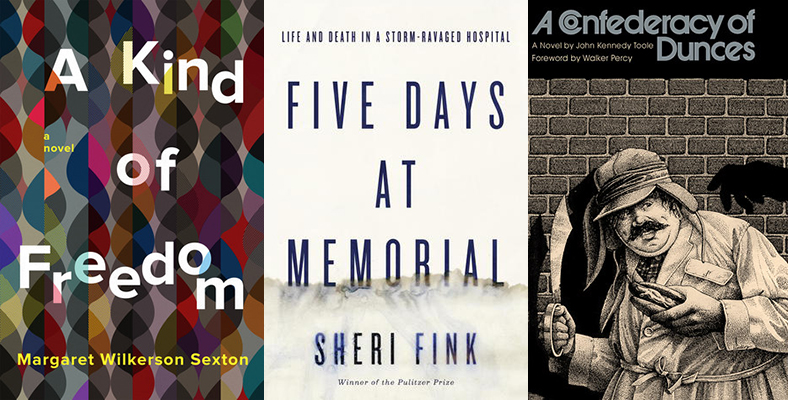
Louisiana
Fiction: A Kind of Freedom, Margaret Wilkerson Sexton
Sexton’s wonderful debut traces a family through three generations in New Orleans—from a star-crossed romance in the 1940s to the crack epidemic of the 1980s to the unfathomable changes wrought by Hurricane Katrina. Injustice, hope, ambition, and the history and truth of New Orleans are the underlying subjects of this novel, explored through the stories of these well-drawn characters.
For a less-contemporary but also-great classic, you might try The Moviegoer, by Walker Percy.
Nonfiction: Five Days at Memorial, Sheri Fink
A harrowing book that describes five days in the aftermath of Hurricane Katrina—five days in which the Memorial Medical Center in New Orleans was without power and staff was forced to create a system that prioritized some patients for evacuation and doomed others to death by euthanasia. The story here is gripping, but the moral questions it raises are even more so, and those will stick with you for a long time.
See also: Do You Know What it Means to Miss New Orleans, edited by David and Bruce Rutledge
The Famous Option: A Confederacy of Dunces, James Kennedy Toole

Maine
Fiction: Olive Kitteridge, Elizabeth Strout
A Pulitzer Prize-winning linked collection of stories (or a novel-in-stories, if you prefer) set in the coastal town of Crosby, Maine, anchored by the large and fairly rude personage of Olive Kitteridge. One of those books that takes regular people in a regular place and makes them feel like epic characters in the story of all our lives.
Nonfiction: We Took to the Woods, Louise Dickinson Rich
The very charming reflections of a woman who picks up and, well, takes to the woods—the woods of northern Maine, where supplies are as scarce as neighbors, but grit and humor are stocked in full.
The Famous Option: The Cider House Rules, John Irving
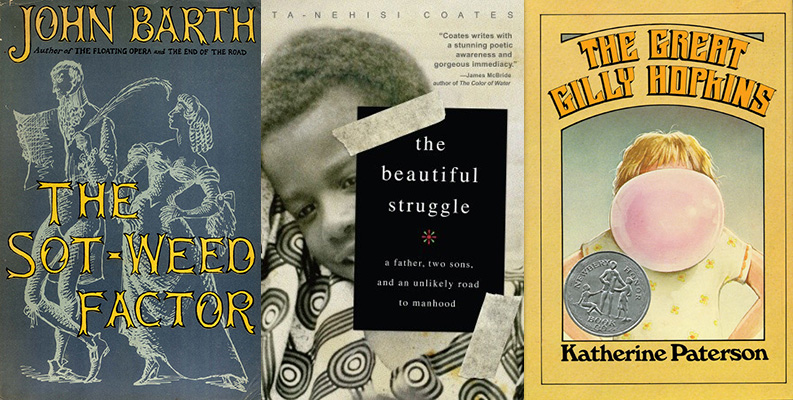
Maryland
Fiction: The Sot-Weed Factor, John Barth
A fictionalized history of Maryland, or a satirical send-up of the historical novel, or a darkly comic postmodern epic, or a maddeningly complex exercise in esoterica, or (and you knew this was coming, didn’t you, you brilliant reader, you) all of the above.
Nonfiction: The Beautiful Struggle, Ta-Nehisi Coates
If you’re looking for some insight into one of America’s leading public intellectuals in your Maryland reading, try Coates’s memoir of growing up in West Baltimore with his father, an intellectual ex-Black Panther with a strict sense of discipline and a lot of love, who drew “a bright circle around 12 through 18. This was the abyss where, unguided, black boys were swallowed whole, only to re-emerge on corners and prison tiers. Dad was at war with this destiny.”
The Famous Option: The Great Gilly Hopkins, Katherine Paterson
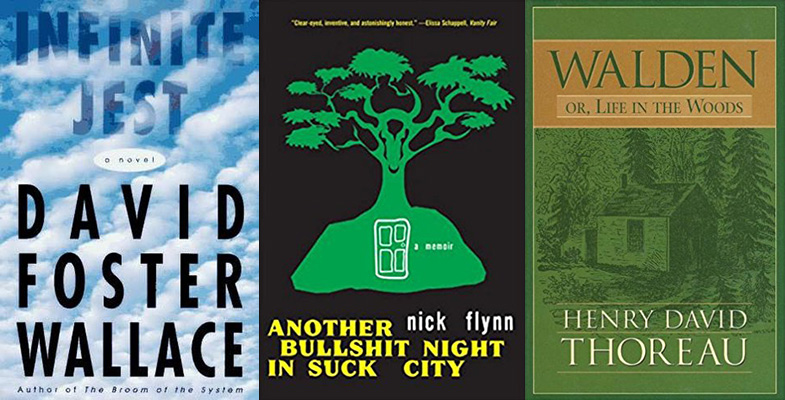
Massachusetts
Fiction: Infinite Jest, David Foster Wallace
I know it’s not cool to like Infinite Jest anymore, but I still love it in all its enormous, cerebral absurdity, and I love the weird version of Boston it illuminates/invents. I’m not alone, either—here’s a detailed map of the area with markers for where moments in the book take place (or are referred to).
Nonfiction: Another Bullshit Night in Suck City, Nick Flynn
I admire Flynn’s poetry (his debut, Some Ether, is remarkable), but I first came to him through this memoir, which I picked up because of its top-notch title. The memoir centers on Flynn’s relationship with his father, whom he met for the first time at a homeless shelter—Flynn Jr. working there, Flynn Sr. sleeping there. The book is grim and hazy, the prose experimental at times and wrenching at others. Not a lot happens, despite the hysterical premise, but isn’t that just like a life?
The Famous Option: Walden, Henry David Thoreau
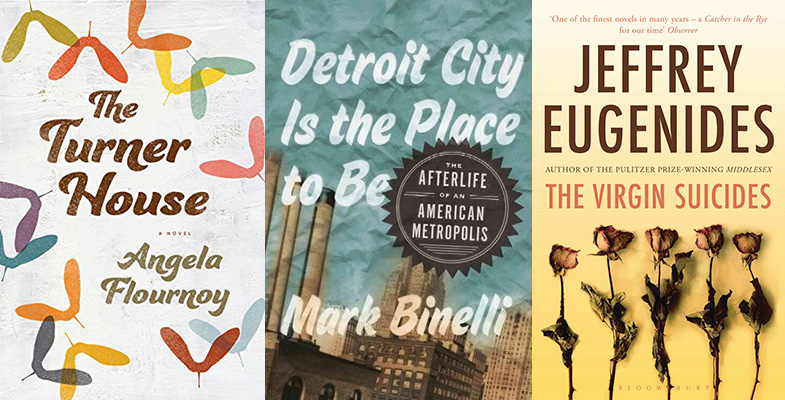
Michigan
Fiction: The Turner House, Angela Flournoy
Flournoy’s recent debut—a finalist for the National Book Award—is a portrait of a family but also a portrait of their city: Detroit. The family home—and what to do about it—is the center of the novel, but the joy of it comes from the many characters, the matter-of-fact magic, and Flournoy’s excellent writing.
Nonfiction: Detroit City Is the Place to Be: The Afterlife of an American Metropolis, Mark Binelli
A series of essays about Detroit that moves past the flashy narratives and digs into the truth—both good and bad, both new and old—of the city.
The Famous Option: The Virgin Suicides, Jeffrey Eugenides
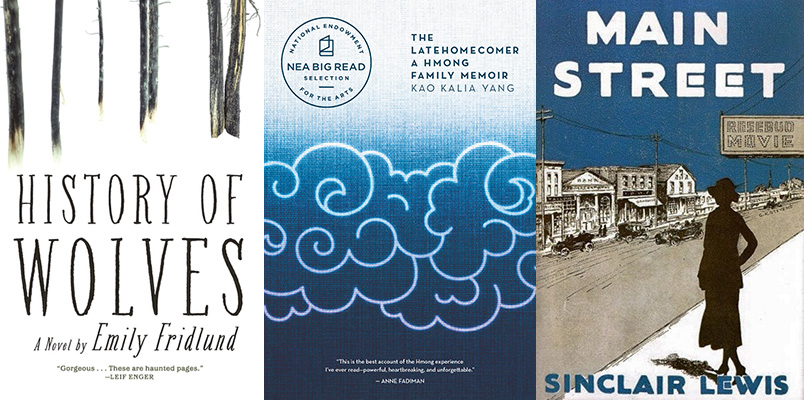
Minnesota
Fiction: History of Wolves, Emily Fridlund
Here’s another recent one: a novel about a 14-year-old girl who finds herself more or less alone, untethered by her ex-commune-member parents, in the cold woods of northern Minnesota—until a new family moves in across the lake and she finds herself all wound up in their mysterious lives. Lots of evocative descriptions of the desolation and isolation of the landscape here, a kind of cold emptiness that permeates the rest of the book.
Nonfiction: The Latehomecomer, Kao Kalia Yang
Kao Kalia Yang was born in a Hmong refugee camp in Vietnam. From there, her family made it to the US, settling in St. Paul. As much as this is a classic American story of the immigrant experience in a new place, it is also an exploration of the Hmong people—a group about which most Americans are completely ignorant. The winner of the 2009 Minnesota Book Award.
The Famous Option: Main Street, Sinclair Lewis
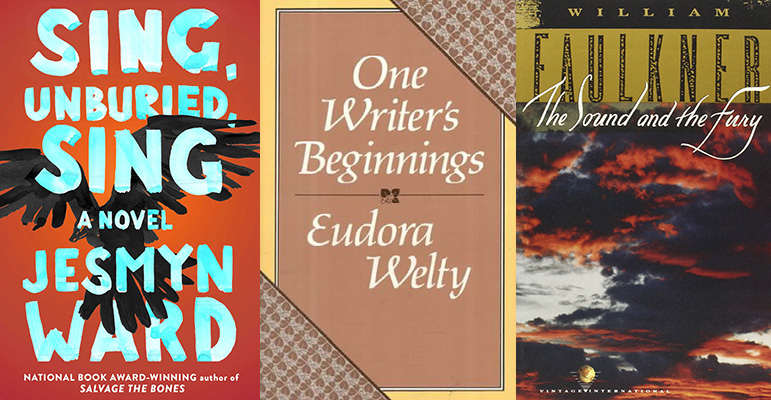
Mississippi
Fiction: Sing, Unburied, Sing, Jesmyn Ward
I love everything Ward writes, so here I’ll just pick her most recent novel, the story of a family haunted—by their own sins, by the sins of their country, by those that have gone and by those that are still here. Ward mixes the terrifyingly real and the silkily surreal in the best of ways, and this novel should be read by everyone.
Nonfiction: One Writer’s Beginnings, Eudora Welty
Eudora Welty’s another one—anything she writes is good. This is her memoir of growing up in Jackson, Mississippi, where she was born in 1909, and of the places she knew, and of course, of becoming one of the south’s greatest writers (though she never would have put it that way) among them.
The Famous Option: The Sound and the Fury, William Faulkner
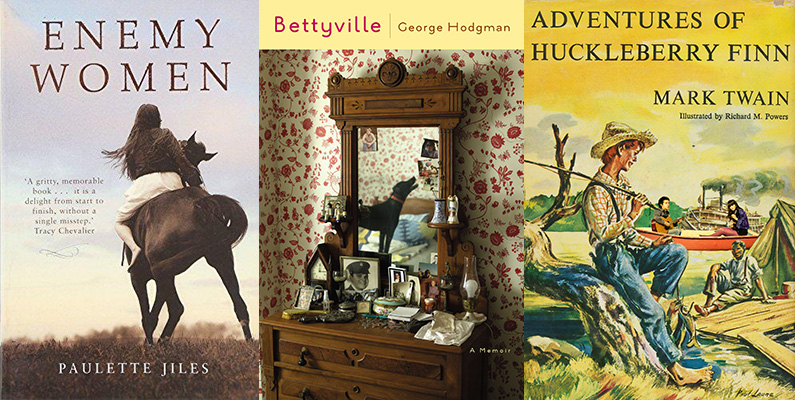
Missouri
Fiction: Enemy Women, Paulette Jiles
This is the wonderful Paulette Jiles’s first novel: the story of a young woman living in the Ozarks during the Civil War. Her family has staunchly remained neutral, but that doesn’t stop soldiers from throwing her in jail. Fantastic, unsentimental writing and a captivating story.
By the way, Missouri has a lot of good fiction to its name. Others I’d have liked to include: Stoner, by John Williams, Winter’s Bone, by Daniel Woodrell, Fifth Born, by Zelda Lockhart, and The Moonflower Vine, by Jetta Carleton.
Nonfiction: Bettyville, George Hodgman
When George Hodgman goes home to Paris (Paris, Missouri) for his mother’s 91st birthday party, he isn’t intending to stay. After all, Paris hadn’t been kind to him as a young gay man, and his mother hadn’t much approved of—or tried to understand—that “lifestyle.” But Betty needs help, and George stays, and the result is a funny, tender-hearted memoir of love and family and coming home again.
See also: the truly hilarious Priestdaddy by Patrica Lockwood.
The Famous Option: Adventures of Huckleberry Finn, Mark Twain

Montana
Fiction: Fools Crow, James Welch
A coming-of-age story about a young Blackfoot living in the Montana he’s always known, where the natural world, dreams, and the old ways guide a peaceful life—but of course, white men are coming to change everything. In some ways, it’s a story we (unfortunately) already know well, but the prose makes it a standout.
Nonfiction: This House of Sky: Landscapes of a Western Mind, Ivan Doig
Doig is a celebrated chronicler of Montana, his homeland, with some sixteen books to his name. In his memoir, a finalist for the 1979 National Book Award for Contemporary Thought, he tells the story of his Montana childhood, with the death of his mother, his grieving father, and the other lives and the wild world that surrounded him.
The Famous Option: A River Runs Through It, Norman Maclean
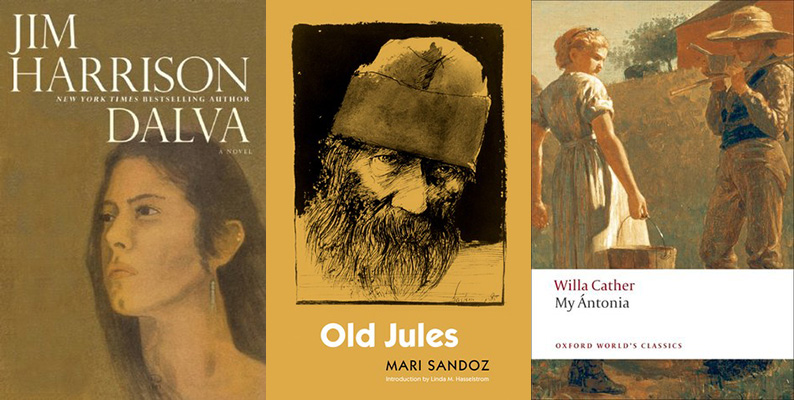
Nebraska
Fiction: Dalva, Jim Harrison
In this novel, a woman named Dalva returns to the Nebraska of her youth to seek out the son she abandoned 30 years earlier, and finds, perhaps it is needless to say, rather more than she expected. Apparently, though not one of Harrison’s most popular books in America, there are many women running around in France who are named after the novel’s eponymous character.
Nonfiction: Old Jules, Mari Sandoz
Nebraskan novelist Mari Sandoz’s Old Jules is a biography of her pioneer father. “I have also,” she writes in the foreword, “tried in a larger sense to make it the biography of a community, the upper Niobrara country in western Nabraska. The book grew out of a childhood and adolescence spent among the story-tellers of the frontier . . . out of the long hours in the smoky old kitchen on the Running Water, the silent hours of listening behind the stove or in the wood box, when it was assumed that of course I was asleep in bed.”
The Famous Option: My Antonia, Willa Cather
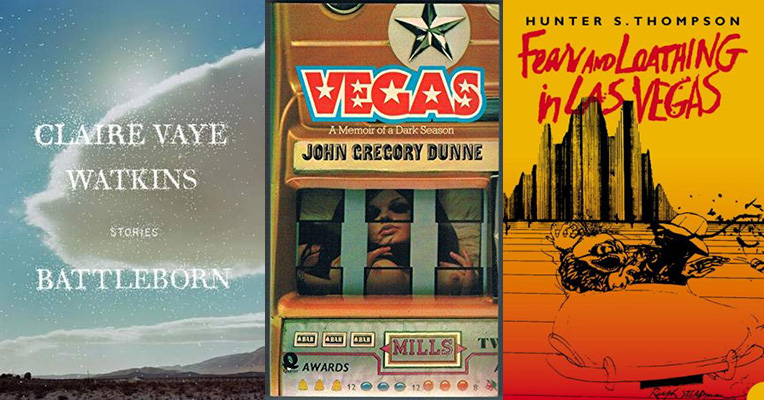
Nevada
Fiction: Battleborn, Claire Vaye Watkins
This is a fantastic collection—strange and wan and oddly sexy and troubled and very much rooted in its setting. As Antonya Nelson put it in the New York Times Book Review, the most striking thing about the book
is its physical landscape, especially as it affects the people who stake their claims on its inhospitable terrain. The reader is introduced to Reno’s founders, both the notorious and the anonymous; to figures who are insiders as well as outsiders; to personalities with historical pedigrees and to ones concocted to perfectly fit the crime. The point of view roams, but the Nevada setting provides a hard ground on which the reader counts for stability. Although the individual stories stand alone, together they tell the tale of a place, and of the population that thrives and perishes therein.
Nonfiction: Vegas: Memoir of a Dark Season, John Gregory Dunne
Despite its subheading, this book isn’t exactly nonfiction. It’s not exactly fiction, either. Dunne told The Paris Review: “I always thought of Vegas as a novel, but Random House said, It doesn’t read like a novel, and I said, A novel is anything the writer says the book is, and since I made most of it up, it can’t be nonfiction. So we ended up calling it a fiction. A lot of it is true. The prostitute did write poetry, although the poetry I used in Vegas is not hers. It was actually written by my wife, who as a child had memorized a lot of Sara Teasdale poems. I can write you bad poetry, she said. So there are two little poems in there that Joan actually wrote.” Which honestly should be all you need to seek it out, but it’s also funny and very filthy, if that helps.
For more traditional works of nonfiction, you might check out Robert Laxalt’s Sweet Promised Land, or any of the many books about how some particular number of particular some kind of people took Vegas and how you can too!
The Famous Option: Fear & Loathing in Las Vegas, Hunter S. Thompson
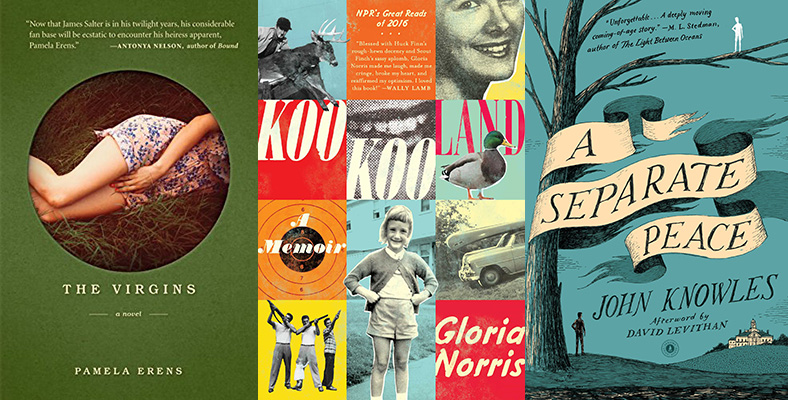
New Hampshire
Fiction: The Virgins, Pamela Erens
I adore this delicious novel about young love and longing at a New Hampshire boarding school, told with a James Salterian distance that turns it into a book as much about the power of storytelling as it is about teenage sex (or the lack thereof).
Nonfiction: KooKooLand, Gloria Norris
In the 1960s, Norris was a tough nine-year-old growing up in the projects of Manchester with a violent and tyrannical father and a terrified mother. Over the course of this memoir, she escapes—but not without leaving some pieces behind, and taking some others along with her.
The Famous Option: A Separate Peace, John Knowles
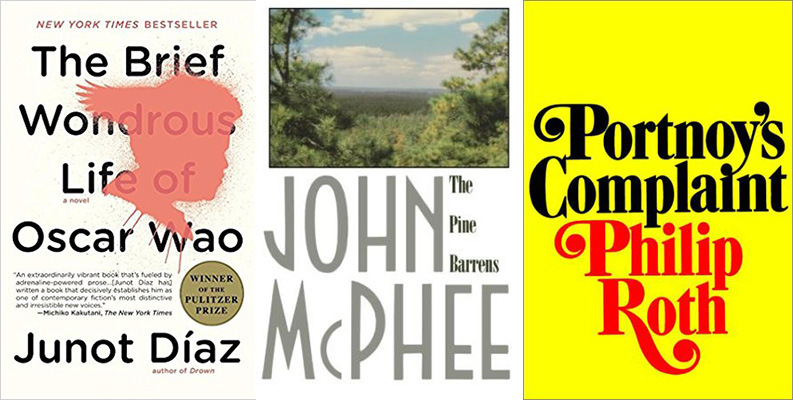
New Jersey
Fiction: The Brief Wondrous Life of Oscar Wao, Junot Díaz
Well, this probably could have gone into the “famous” category, what with its heap of prizes, but it seemed ill-advised to crowd Roth, considering he’s not going to get any other love on this list. Díaz’s fantastic debut novel stars the unforgettable Oscar, a chubby Dominican-American nerd who may or may not be a victim of an old family curse that reached across the ocean from the Dominican Republic to Paterson, New Jersey.
A hat tip, too, to David Gates’s Jernigan, another fine Jersey novel about a young American discontent.
Nonfiction: The Pine Barrens, John McPhee
Anyone who’s seen The Sopranos knows something about the Pine Barrens of New Jersey, but McPhee’s work uncovers much more—about the ecology and history of the unusual place, a vast silty wilderness in the middle of the state, as well as those who live there, the pineys, who many in the state consider to be “weird and sometimes dangerous barefoot people who live in caves, marry their sisters and eat snakes.” A relatively early example of McPhee’s wonderful writing about place.
The Famous Option: Portnoy’s Complaint, Philip Roth
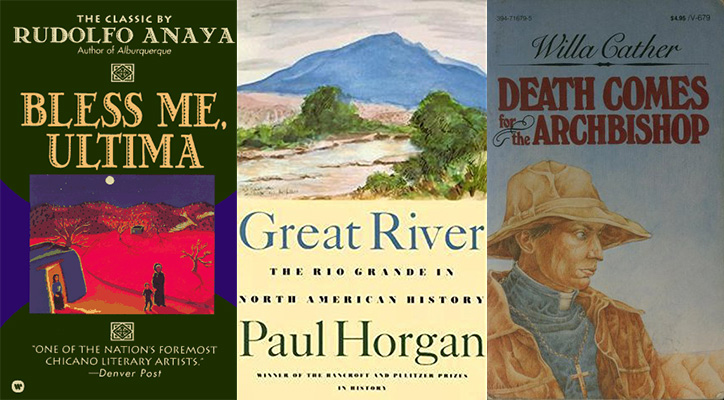
New Mexico
Fiction: Bless Me, Ultima, Rudolfo Anaya
Take the coming-of-age story you know and add a curandera—the titular healer who comes to live with six-year-old Antonio Juan Márez y Luna and his family in in 1940s Guadalupe, New Mexico. Catholicism and magic, man and nature, mother and father are all at odds here, but the central story is about the relationship of Antonio and Ultima, who does her best to guide him through the conflicts.
Nonfiction: Great River, Paul Horgan
Horgan’s epic Pulitzer Prize-winning book, published in 1955, traces the Rio Grande through the Southwest, telling the stories of multiple peoples of the region as it goes. This was only the first of two Pulitzers Horgan would get for New Mexico-related works—the other, Lamy of Santa Fe, rather undermines Willa Cather’s classic below.
The Famous Option: Death Comes for the Archbishop, Willa Cather
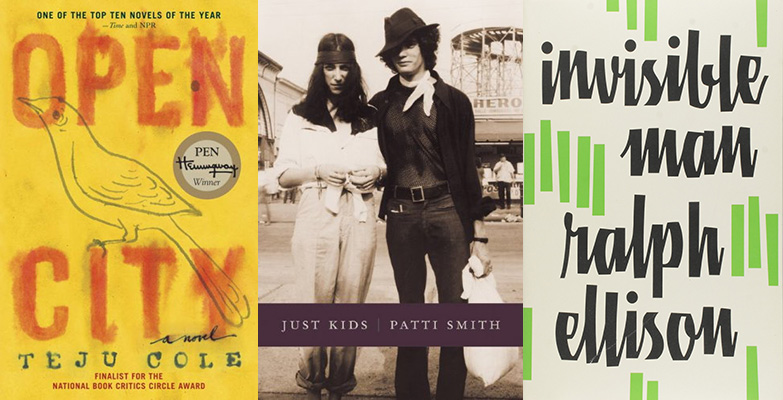
New York
Fiction: Speedboat, Renata Adler · Open City, Teju Cole
Like California, New York is a place of many novels, and so I couldn’t limit to myself to just one here. Even two is ludicrously insufficient—you know the drill. For me, Adler’s Speedboat, despite being written in the 70s, is the novel that most closely reflects the feeling of being a young woman in New York City, in all its poetic, fragmented, harsh, discursive dream-sense. Cole’s Open City represents an experience outside of my own—its protagonist, so to speak, is a young Nigerian immigrant—but is equally recognizable and vital to anyone who has walked the streets of the city, both feet and brain loosed to wander. Both of these selections, I see only now, are essentially plotless, which seems rather fitting for our fair city, in which chance and change and aimlessness reign.
Of course, if you so desire, you may exchange either of the above for Hanya Yanagihara’s A Little Life, Don Delillo’s Underworld, Toni Morrison’s Jazz, Michael Chabon’s The Amazing Adventures of Kavalier & Clay, Edith Wharton’s The Age of Innocence, Chang-rae Lee’s Native Speaker, etc. etc. etc. ad infinitum. Everyone has their own New York, after all.
Nonfiction: Just Kids, Patti Smith · Up in the Old Hotel, Joseph Mitchell
Two modern classics here: Patti Smith’s touching memoir of her friendship with Robert Mapplethorpe, spangled with 60s luminaries and luminaries-in-training, and the 1992 mega-collection of Joseph Mitchell’s writing about New York, all of it originally published in The New Yorker.
The Famous Option(s): The Great Gatsby, F. Scott Fitzgerald · The Catcher in the Rye, J. D. Salinger · Invisible Man, Ralph Ellison
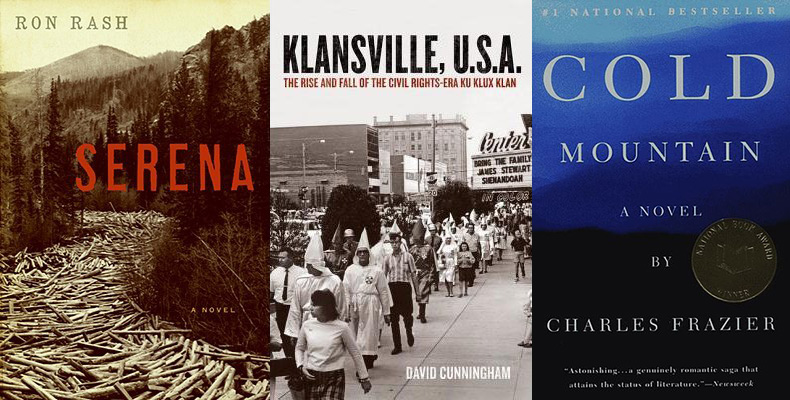
North Carolina
Fiction: Serena, Ron Rash
Ron Rash’s fourth novel is sometimes likened to an Appalachian Macbeth, with king and queen as Depression-era logging magnates—but honestly, Serena is much more terrifying than Lady Macbeth: the trees might come to her, but she’s going to cut them all down, and anyone else who might come with them. And the trees are in full effect here, as Rash’s lyrical descriptions of the North Carolina mountains flesh out the book in all its grim glory.
Nonfiction: Klansville, USA: the Rise and Fall of the Civil Rights-Era Ku Klux Klan, David Cunningham
Apparently—and somewhat incredibly—in the 1960s, North Carolina had more Klan members than all of the other southern states combined. Also incredibly—and horribly, and disgustingly, and frighteningly—the history of the KKK has become suddenly much more relevant to your daily life than it was a month ago. Here’s some history.
The Famous Option: Cold Mountain, Charles Frazier
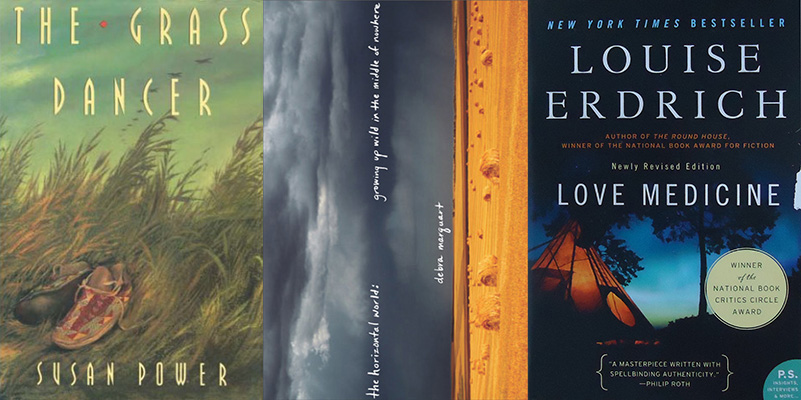
North Dakota
Fiction: The Grass Dancer, Susan Power
Power’s debut novel, set on a North Dakota Sioux reservation, won the Hemingway Foundation/PEN Award for Best First Fiction when it was published in 1995. It jumps around, through decades and characters, but somewhat centering on the young Harley Wind Soldier, whose mother has been silent ever since his father and brother died seventeen years before.
Though I’ve barred myself from including wide-ranging travel narratives, I do feel that I should mention John Steinbeck’s musings on North Dakota in Travels with Charley here:
Curious how a place unvisited can take such a hold on the mind so that the very name sets up a ringing. To me such a place was Fargo, North Dakota. . . If you will take a map of the United States and fold it in the middle, eastern edge against western, and crease it sharply, right in the crease will be Fargo. On double-page maps sometimes Fargo gets lost in the binding. That may not be a very scientific method for finding the east-west middle of the country, but it will do. But beyond this, Fargo to me is brother to the fabulous places of the earth, kin to those magically remote spots mentioned by Herodotus and Marco Polo and Mandeville. From my earliest memory, if it was a cold day, Fargo was the coldest place on the continent. If heat was the subject, then at that time the papers listed Fargo as hotter than any place else, or wetter or drier, or deeper in snow. That’s my impression anyway.
Nonfiction: The Horizontal World: Growing Up Wild in the Middle of Nowhere, Debra Marquart
Poet Debra Marquart’s memoir of growing up on a dairy farm in North Dakota begins with opposition. “Farmboys,” she writes. “How we avoided them when they came around, their hands heavy with horniness, their bodies thick with longing. Be careful of farmboys, we warned each other. They know how to plant seeds.” And all oppositions in this volume come down to one: the beauty of her ancestral home, and her nagging connection to it, rams up against Marquart’s desire to leave, to get as far away as possible, resulting in a lovely meditation on identity and place.
The Famous Option: Love Medicine, Louise Erdrich
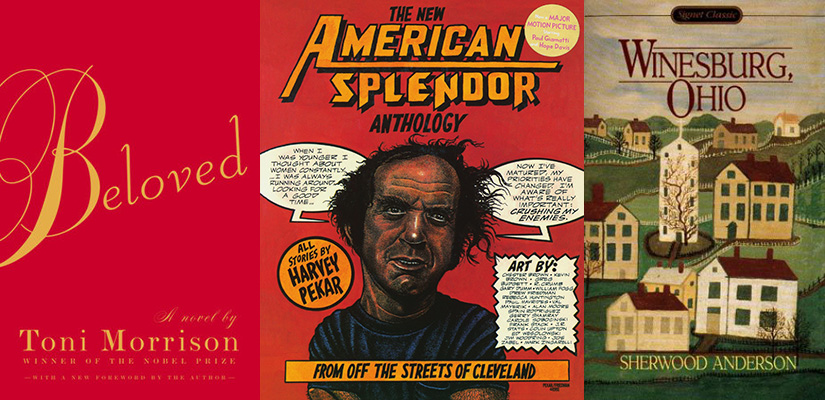
Ohio
Fiction: Beloved, Toni Morrison
Maybe the greatest American novel of all time—a ghost story about the America’s biggest and most omnipresent demon. Morrison’s The Bluest Eye and Sula are also essential Ohio reading. Luckily, your bookshelf has no limits.
Also recommended: Celeste Ng’s Everything I Never Told You, in which a young girl disappears from a small town in Ohio in the 1970s.
Nonfiction: American Splendor, Harvey Pekar
A chronicle of the day-to-day goings-on and existential crises of Harvey Pekar, native of Cleveland, Ohio, written by Pekar and illustrated by such luminaries as Alison Bechel, Robert Crumb, and Gilbert Hernandez. Surprisingly addictive.
The Famous Option: Winesburg, Ohio, Sherwood Anderson

Oklahoma
Fiction: True Grit, Charles Portis
This is a delightful novel, in which the very forthright Mattie Ross hires a man “with grit” to help her hunt down the villain who has killed her father and fled into the Indian territories (now Oklahoma). Though much of the novel takes place in Arkansas, all the really memorable parts (the villain-shooting, the horseback-riding, the trapped halfway inside a bat cave while rattlers swarm out of a nearby skeleton-ing) happen over the border, and perhaps this is why is has been referred to as “The Great Oklahoma Novel.” In either state, it’s a must-read.
Nonfiction: Killers of the Flower Moon, David Grann
The recent blockbuster from New Yorker writer David Grann tells the story of the Osage, Native Americans who are shoved into a corner of Oklahoma—only to find oil beneath it and become extremely wealthy. Then someone begins to murder them. More than two dozen people were shot, poisoned, or otherwise killed between 1920 and 1924, and eventually, the F.B.I was sent to investigate. Grann turns the whole story into a captivating large-scale murder mystery that also happens to be true.
The Famous Option: The Outsiders, S. E. Hinton
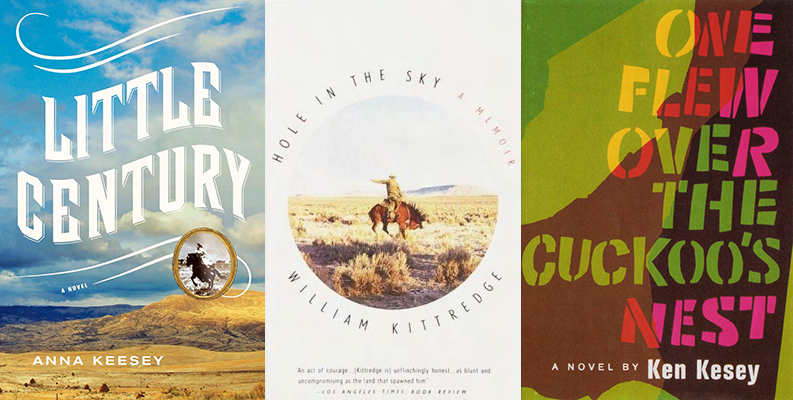
Oregon
Fiction: Little Century, Anna Keesey
A vivid novel about a teenage orphan who does what all orphans used to do, and heads west, to the frontier town of Century, Oregon, where she finds her cattle ranching cousin and a whole world she never imagined. Jonathan Evison puts it this way in the New York Times Book Review:
The real star of the novel is Oregon’s high desert, a vast, quiet plain Keesey captures in many of its dynamic moods, in language ranging from the plainspoken to the elegant. Esther observes the lay of the land after arriving: “As far as she might walk to, or even see, to one side or the other, all is gray and sleeping under a shiver-thin coverlet of old snow.” And like all well-wrought settings, Keesey’s high desert has woven itself into the fabric of its inhabitants, as it has for Pick: “He remembered, always, the desert of his childhood. The vast quiet, the singular negotiations between a cold, calm man and a colder, calmer plain.”
I also have to mention Geek Love, by Katherine Dunn. What’s more Portlandian than freaks, amirite?
Nonfiction: Hole in the Sky, William Kittredge
This gorgeous memoir takes place on Kittredge’s family cattle land in Warner Valley, what should have been a paradise and instead was simply the setting for his fall. In the first chapter, he writes:
Maybe children wake to a love affair every other morning or so; if given any chance, they seem to like the sight and smell and feel of things so much. Falling for the world could be a thing that happens to them all the time, I hope so, I hope it is purely commonplace. I’m trying to imagine that it is, that our childhood love of things is perfectly justifiable. Think of light and how far it falls, to us. To fall, we say, naming a fundamental way of going to the world–falling.
. . .
In the evening my father would drive along the central banks to study his crops as they emerged in undulating rows across the dark peat soil of the old swamplands. We could speculate on how much the seedlings had grown in just one day. We thought we could smell the growing. That little boy had no intimation that those moments would come to stand in memory as his approximation of perfection: his family, his life before him, the world in renewal.
The Famous Option: One Flew Over the Cuckoo’s Nest, Ken Kesey
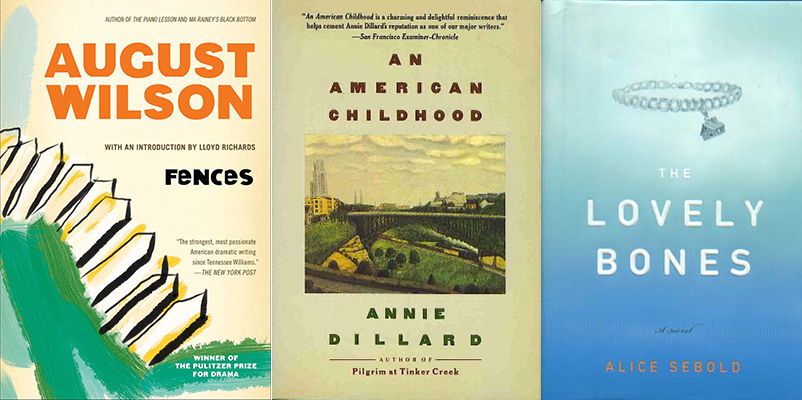
Pennsylvania
Fiction: The Pittsburgh Cycle, August Wilson
Well, I’m bending the rules, because of course these are plays—ten plays, nine of which are set in the Hill District of Pittsburgh, five of which have been awarded New York Drama Critics’ Circle Awards, and two of which have been awarded Pulitzer Prizes, and one of which has a Tony. But they are as literary as any of the novels on this list, intense dramas of the African-American experience, and influenced, as Wilson himself put it, by the “four Bs—the primary one being the blues, then Borges, Baraka, and Bearden.”
I also want to mention John Edgar Wideman’s Philadelphia Fire, a ferocious novel inspired by the real-life 1985 bombing of an African-American commune in Philadelphia.
Nonfiction: An American Childhood, Annie Dillard
In Dillard’s lovely memoir of growing up in Pittsburgh, she remembers Penn Avenue, which “smelled of gasoline, exhaust fumes, trees’ sweetness in the spring, and, year round, burnt grit,” the “orange, clangy, beloved” streetcars, the cobblestones made from river mud, the “sidewalks whose topography was as intricate as Pittsburgh’s, and as hilly . . . cut into so many parts, so many legal divisions, that no one was responsible for all of it, and it all crumbled.”
The Famous Option: The Lovely Bones, Alice Sebold
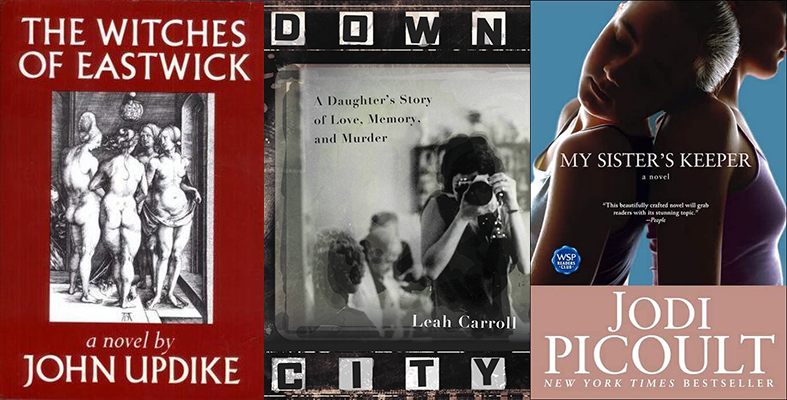
Rhode Island
Fiction: The Witches of Eastwick, John Updike
A coven of three thrives in the town of Eastwick: two divorcées and a widow, all of whom, once shed of their husbands, developed uncanny powers and now use them for general mischief and misandry. Enter Darryl Van Horne, mysterious un-handsome stranger, who rather stirs the cauldron, resulting in death, destruction, and a darkly hilarious ending.
Nonfiction: Down City, Leah Carroll
When you think ‘Rhode Island,’ you probably don’t immediately think ‘mafia’—but it was mob-connected drug dealers who murdered Leah Carroll’s mother when she was a toddler, and who got off light in return for spilling what they knew. Her alcoholic father, on the other hand, dies while she’s a teenager. This memoir is a portrait of them both, and of the daughter they left scrambling, and finally the story of the the double-sided coin of Providence in the 90s, both the suburbs and the seedy side.
The Famous Option: My Sister’s Keeper, Jodi Picoult
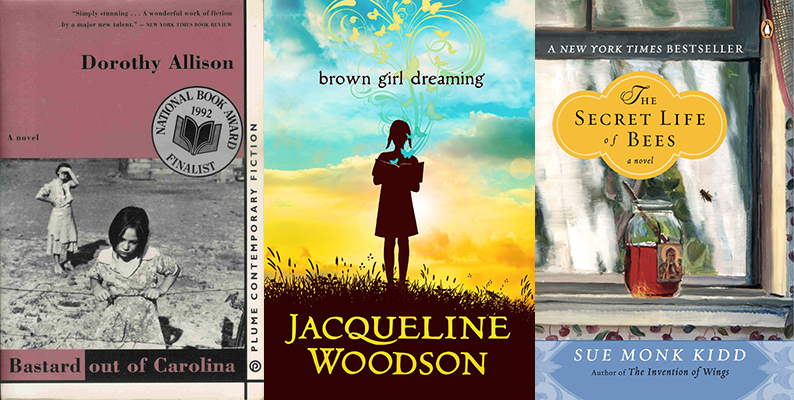
South Carolina
Fiction: Bastard Out of Carolina, Dorothy Allison
A classic of rural Southern literature, this harrowing novel is narrated by Bone, whose mother, in an attempt to legitimize the child she had out of wedlock at 15, marries a man (“Daddy Glen”). Perhaps needless to say, he only makes things worse, sexually abusing his stepdaughter and driving an even bigger wedge through the center of the family.
Nonfiction: Brown Girl Dreaming, Jacqueline Woodson
Woodson’s elegant memoir in verse, which won a 2014 National Book Award, tells the story of her childhood in Greenville, South Carolina (and later, New York, which affords her an effective contrast—”We remember the collards growing/ down south, the melons, fresh picked/ and dripping with a sweetness New York / can never know”) in the late 60s. It’s a book about transitions, a girl becoming a writer, a family moving from South to North, and the larger cultural shift, too—or lack thereof: “In downtown Greenville, / they painted over the WHITE ONLY signs, / except on the bathroom doors, / they didn’t use a lot of paint/ so you can still see the words, right there / like a ghost standing in front / still keeping you out.”
The Famous Option: The Secret Life of Bees, Sue Monk Kidd
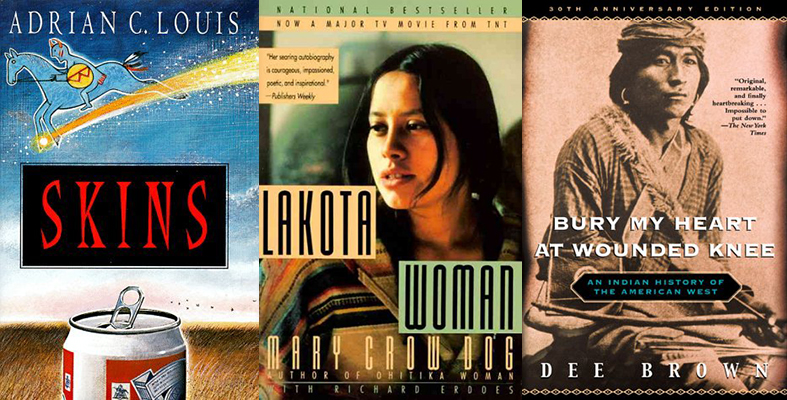
South Dakota
Fiction: Skins, Adrian C. Louis
This debut novel by Louis, also a prolific poet, is set on South Dakota’s Pine Ridge Reservation, where beleaguered tribal cop—complete with alcoholic brother and failing marriage—Rudy Yellow Shirt hits his head and wakes up changed into a ferocious vigilante and sets out to save, or otherwise avenge, his people. It doesn’t turn out exactly right, as you might imagine. A grim portrait of life on a reservation, infused with dark humor and not a little violence.
See also: Shadowbahn, by Steve Erickson, in which the twin towers reappear in the badlands, and one of them has Elvis’s twin living inside.
Nonfiction: Lakota Woman, Mary Brave Bird (Mary Crow Dog)
Brave Bird’s memoir, which won an American Book Award in 1991, describes her youth on the Rosebud Indian Reservation in South Dakota and her participation in the American Indian Movement, including her participation at seventeen in the incident at Wounded Knee in 1973, where, “during a firefight, with bullets crashing through one wall and coming out the other,” she gave birth to her first child.
The Famous Option: Bury My Heart at Wounded Knee, Dee Brown
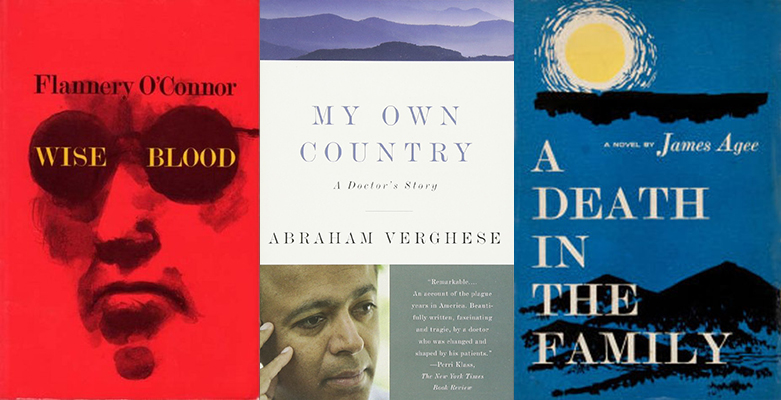
Tennessee
Fiction: Wise Blood, Flannery O’Connor
O’Connor’s first novel is a brutal and bizarre masterpiece of Southern Gothic literature, in which a man—the grandson of a preacher—comes back from World War II a sworn atheist, but finds himself not quite capable of escaping his belief. As O’Connor herself put it in the preface to a 1962 edition, “The book was written with zest and, if possible, it should be read that way. It is a comic novel about a Christian malgré lui, and as such, very serious, for all comic novels that are any good must be about matters of life and death.”
Nonfiction: My Own Country, Abraham Verghese
In the mid-80s, Abraham Verghese was a young doctor living in Johnson City, Tennessee, “the embodiment of small-town America, 72 churches watching over the flock, the perfect symmetry of the Lions and Kiwanis and Rotary clubs, with their staggered meeting dates.” Then patients began appearing with an unknown, deadly illness. A specialist in infectious diseases, Verghese was the best-equipped doctor in the area to deal with this sudden rash of what turned out of HIV-positive patients, but still, he watched the number of AIDS cases go from zero to eighty over four years. I read this memoir long ago, in high school, and still I remember it, and the sense of both the specific place and the country at large that it imparted.
The Famous Option: A Death in the Family, James Agee
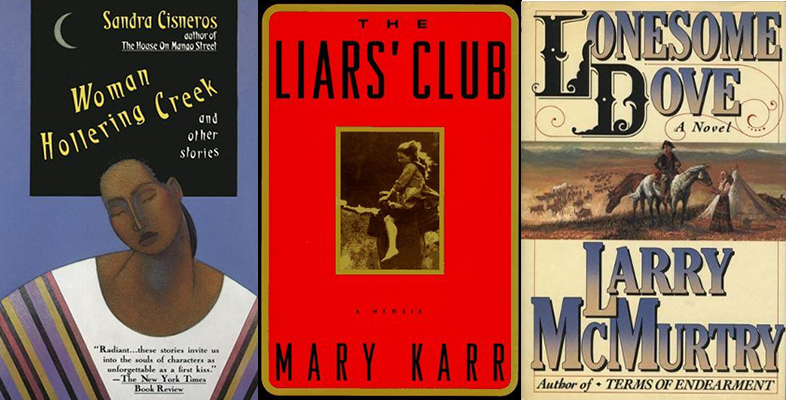
Texas
Fiction: Woman Hollering Creek, Sandra Cisneros
A classic collection of short stories—mostly about Mexican-American women, largely set in San Antonio, though the border is crossed and crossed again in mind and body—separated into three sections that investigate childhood, adolescence, and adulthood. The end effect is a tapestry of longing and belonging, a portrait in pattern.
Nonfiction: The Liar’s Club, Mary Karr
No one writes like Mary Karr—all whip-crack heart and shiny-edged eyes—and her memoir of growing up in an East Texas oil town is a full-fledged knockout.
The Famous Option: Lonesome Dove, Larry McMurtry
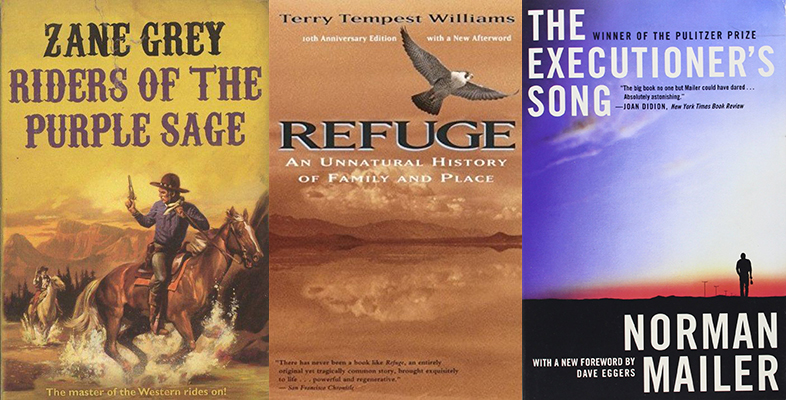
Utah
Fiction: Riders of the Purple Sage, Zane Grey
One of the early important Westerns, written in 1912 by prolific author, American West mythologizer, and capable dentist Zane Grey, in which a young woman escapes the Mormon community that persecutes her, picking up a couple of cowboys along the way.
Nonfiction: Refuge: An Unnatural History of Family and Place, Terry Tempest Williams
“Everything about Great Salt Lake is exaggerated,” Terry Tempest Williams writes in the prologue to her landmark work. “[T]he heat, the cold, the salt, and the brine. It is a landscape so surreal one can never know what it is for certain.” What is for certain is that her mother is dead, from cancer brought on by nuclear testing in the nearby desert, just like most of the other women in her family. What is for certain is that the birds are disappearing. This is an evocative memoir of loss joined with an examination of humanity’s fraught relationship to nature—and certain humans’ peace with it.
The Famous Option: The Executioner’s Song, Norman Mailer
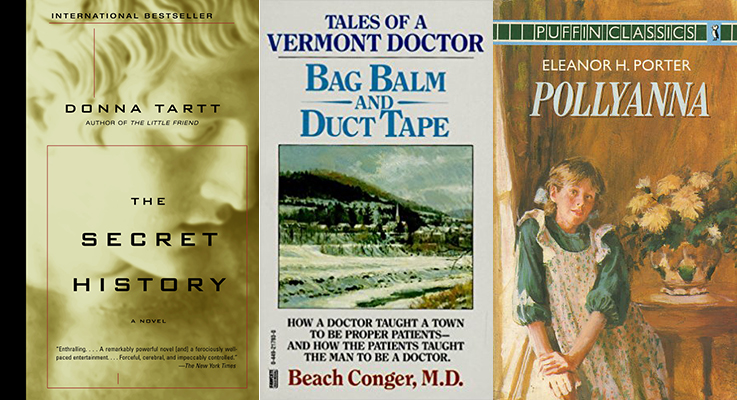
Vermont
Fiction: The Secret History, Donna Tartt
I lived for four years in rural Vermont, and I can tell you true: no novel feels as much like the state as Donna Tartt’s masterpiece of a debut. It follows a group of classics students at the fictional Hampden College as they seek transcendence and devolve into murder—and then as they deal with the aftermath. There is plenty of snow.
Nonfiction: Bag Balm and Duct Tape: Tales of a Vermont Doctor, Beach Conger
Everyone in Vermont uses Bag Balm, and in case you don’t know what that is, it is a sort of salve originally meant to rub into cows’ udders (those would be the bags) after milking, but which Vermont humans use to treat chapped lips, rough hands, burns, and skin irritations of almost every variety. This chummy memoir tells the story of a young M.D. who comes from California to rural Vermont and adapts to life as a country doctor.
The Famous Option: Pollyanna, Eleanor H. Porter

Virginia
Fiction: The Known World, Edward P. Jones
Set 20 years before the Civil War in Manchester County, this Pulitzer Prize-winning debut tells the story of a young slave who became a slave owner himself, before dying at the age of 31 and leaving his wife to grapple with his legacy. A complex and challenging novel that everyone should read.
Nonfiction: The Hemingses of Monticello: An American Family, Annette Gordon-Reed
Charlottesville has a bizarre relationship with Thomas Jefferson—as Jia Tolentino recently mentioned in her piece about the city’s history of racism in The New Yorker—and Monticello makes for an uneasy tourist attraction. But it’s still a fascinating one, with tendrils that spool out in many directions, including that of Sally Hemings, the slave Thomas Jefferson kept as a “mistress.” Historian Annette Gordon-Reed’s Pulitzer Prize and National Book Award-winning book tells the story of Sally Hemings and her family—including the six children she had with Jefferson, and spanning from the 1700s to 1826—as well as the history of slavery in Virginia.
I must also mention Hold Still, the memoir by photographer Sally Mann, which skillfully evokes the loamy magic of certain parts of the state, using both narrative and photography to weave together a sometimes-disturbing, sometimes-idyllic view.
The Famous Option: Bridge to Terabithia, Katherine Paterson
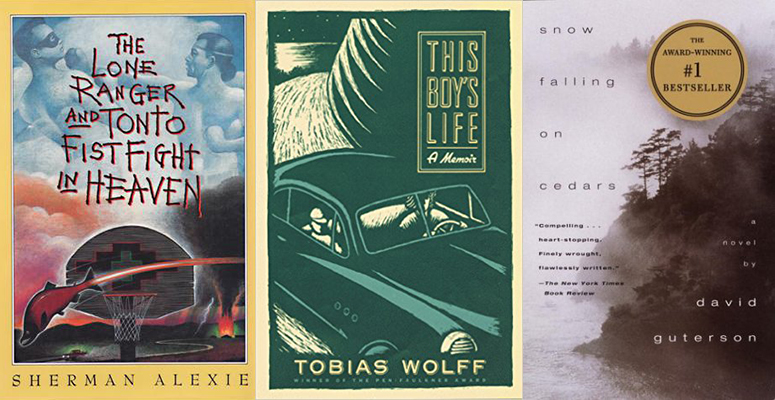
Washington
Fiction: The Lone Ranger and Tonto Fistfight in Heaven, Sherman Alexie
Really, everything Alexie writes is a delight, so if you’re going to Washington (or even if you aren’t—the book ranges a bit anyway), I’d suggest loading up. This collection of connected short stories focuses primarily on Victor Joseph and Thomas Builds-the-Fire, young Native American men who live on a reservation in Spokane. Alexie is adept at braiding the realistic and surrealistic, the contemporary and the traditional, the hilarious and the heartbreaking, and these stories add up to exhilarating portraiture of a place and a group of people.
Nonfiction: This Boy’s Life, Tobias Wolff
A darkly funny, fraught memoir of a troubled childhood spurred by an abusive stepfather in Concrete, Washington that proves going West doesn’t always—or perhaps ever—solve all your problems. A useful American lesson, that.
The Famous Option: Snow Falling on Cedars, David Guterson
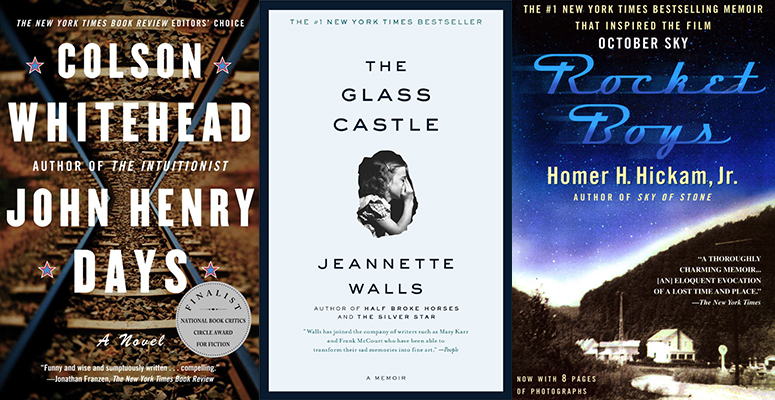
West Virginia
Fiction: John Henry Days, Colson Whitehead
Colson Whitehead’s John Henry Days tackles the story of American folk hero John Henry (the “steel-driving man”) through an opportunistic and kind of terrible young journalist, J. Sutter, sent to West Virginia to attend a John Henry festival and see the unveiling of a John Henry stamp.
I also want to mention Ann Pancake’s Strange as This Weather Has Been, a heavily-researched and brilliantly-written novel about the ravages of coal mining on one particular family.
Nonfiction: The Glass Castle, Jeannette Walls
This widely-beloved memoir is about Walls and her siblings growing up in (among other places) the ditchwater town of Welch, West Virginia, at the mercy of their alcoholic father and erratic mother. Now a film—but read it first.
The Famous Option: Rocket Boys, Homer Hickam
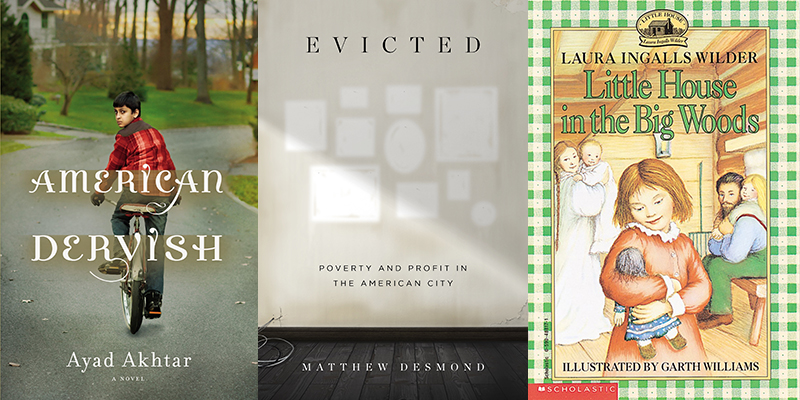
Wisconsin
Fiction: American Dervish, Ayad Akhtar
In this first novel, Akhtar tells one of the most American stories there is: that of a first-generation citizen, the child of immigrants, carving out a place for himself that has room for both his heritage and the possibilities open before him. Hayat is a young Pakistani-American whose life is upended when his mother’s beautiful friend Mina comes to stay with them in Milwaukee, bringing with her a deep faith—and a disruptive one. As Akhtar has said, the novel asks questions about femininity and faith, and the way these intersect with cultural conflicts in America. Mina, after all, “is imbued with a spiritual force, the book’s most powerful and inspiring agent of change. And yet she is a paradox: deeply devout, bound by her tradition, subject—in tragic ways—to a patriarchal order with which she struggles.”
Also, a shout-out to Craig Thompson’s Blankets, which nails the snow and isolation involved in any Wisconsin winter.
Nonfiction: Evicted, Matthew Desmond
Forget having a room of one’s own—many American citizens can’t even keep a roof over their heads. The winner of this year’s Pulitzer Prize in general nonfiction, Desmond’s crushing book is a deep-dive into the a varied group of people struggling to keep shelter in Milwaukee, and the cycle of poverty, loss, and systematic disenfranchisement that keeps shoving them out onto the streets.
The Famous Option: Little House in the Big Woods, Laura Ingalls Wilder
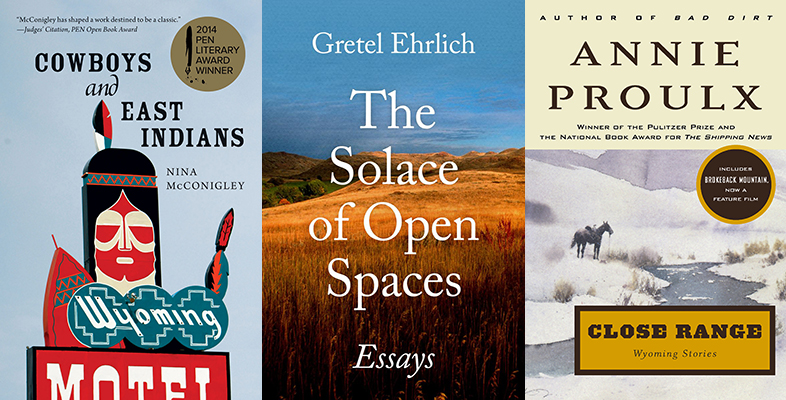
Wyoming
Fiction: Cowboys and East Indians, Nina McConigley
Here’s a version of Wyoming you may not be familiar with, even if you’ve spent every second of your life there: Wyoming as seen from the perspective of the other kind of Indian—the kind actually from India. These ten stories examine the many facets of being brown in Wyoming—and being a cross-dresser, a mother, kleptomaniac exchange student—but also the feeling of Wyoming itself. It won a 2014 Pen Open Book Award, and the judge’s citation noted that the book “gives us Wyoming precisely the way we expect it—in landscape, sky, and animal life—and in ways we don’t.” Which is precisely what I want when I travel by literature.
Nonfiction: The Solace of Open Spaces, Gretel Ehrlich
This classic series of essays relates Ehrlich’s experiences living on a small farm in Wyoming (cow punching is a thing), but also uses her specific stance to take a wider look at America at large. For instance, in one essay, she writes:
From the clayey soil of northern Wyoming is mined bentonite, which is used as filler in candy, gum, and lipstick. We Americans are great on fillers, as if what we have, what we are, is not enough. We have a cultural tendency toward denial, but being affluent, we strangle ourselves with what we can buy. We gave only to look at the houses we build to see how we build against space, the way we drink against pain and loneliness. We fill up space as if it were a pie shell, with things whose opacity further obstructs our ability to see what is already there.
Clarity of vision is of paramount importance here. The writing is beautiful but not quaint, particularly, and the journey is one of knowledge and discovery. As Judith Moore put it in The New York Times:
Although Miss Ehrlich’s suffering eventually abates, what comfort Wyoming gives her comes hard won. The Solace of Open Spaces depends upon none of the cheap effects—purple sunset, the face of God in still water—that breed what theologians call ”cheap grace,” salvation too easily won. By the time Miss Ehrlich meets a Wyoming man and they marry, she has been to the mountaintop and seen the mountain for what it is.
The Famous Option: Close Range, Annie Proulx
Emily Temple
Emily Temple is the managing editor at Lit Hub. Her first novel, The Lightness, was published by William Morrow/HarperCollins in June 2020. You can buy it here.











